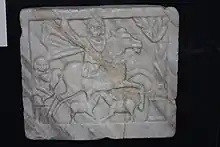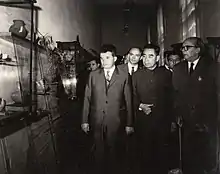Constanța History and Archaeology Museum
The Constanța History and Archaeology Museum (Romanian: Muzeul de Istorie Națională și Arheologie) is a museum located at 12 Piața Ovidiu, Constanța, Romania.
.jpg.webp)




History
As early as 1878, the year when the Romanian Old Kingdom acquired Northern Dobruja, its first prefect, Remus Opreanu, proposed creating an archaeology museum. This was soon done, in Opreanu’s office. After the prefecture building burned down in 1882, the surviving pieces were housed in the public garden pavilion. By 1911, the surviving collection was in storage at a local high school. That year, Vasile Pârvan, head of the National Museum of Antiquities, wrote a report calling for a permanent museum in Constanța; this is considered its founding charter. From 1912, the museum was located in a kiosk in the city park. It was moved into a wing of the city hall in 1928, opening two years later.[1]
By the 1930s, the museum was becoming crowded; donations, acquisitions and excavations were constantly expanding the collection. In 1937, the archaeology section held 272 items. In 1957, the museum moved into a new building, now the Archbishop's Palace. It featured exhibit space, a restoration laboratory, a specialized library and modern equipment. Eventually, this space too became insufficient, as the history section stopped with the Middle Ages. In 1977, the museum moved into the entire city hall building.[1]
Collection
The ground floor of the museum features two rooms of archaeological finds. The middle floor describes the ancient and medieval history of Dobruja. The highest floor is dedicated to modern history, as well as thematic expositions.[1] The archaeological collection includes 24 sculptures (statues and bas reliefs) found in 1962 while foundations were being dug for an apartment building. That very summer, 300,000 visitors saw the new discovery, which has remained a matter of scientific interest. The centerpiece is a glycon dating to the 2nd century AD. Sculptures of Tyche, the protecting divinity of Tomis (ancient Constanța), and of Pontus, god of the Black Sea, date to the same period.[2] A bust of Isis and a relief showing a Thracian horseman are from the 3rd century.[3]
Other items include an 18th-century bronze brooch found at Vadu in 1989; a 2nd or 3rd-century gold and glass necklace from Mangalia (Callatis), found 1985; a gold and stone medallion from the 1962 excavation; a 3rd or 4th-century gold earring with goat pendant from Vama Veche; a 2nd-century gold ring with gem inset from Tomis; and a 4th to 6th-century gold cross with gem inset found at Mangalia in 1983.[4] Finally, there is a 4th-century hypogeum style tomb discovered in Constanța in 1988. It is noted for the artistic value of the painted interior, featuring elements both of Ancient Greek religion and Christianity.[5]
Building
The museum building was designed as a city hall by architect Victor Ștefănescu. Prince Ferdinand laid the cornerstone in May 1912. Construction was halted in 1913, restarted in summer 1914, then stopped again during World War I. The building was inaugurated in July 1921. Aside from its political and administrative function, it housed a beer hall in the basement, with room for 300 customers; as well as a coffee and pastry shop in a ground floor wing, and a restaurant in the other wing.[6]
The structure is in Neo-Brâncovenesc style, with a loggia, columns and small windows. At the time of its construction, was criticized for its excessive cost, and for blocking wind from the sea, creating a heat island.[7] The building is listed as a historic monument by Romania's Ministry of Culture and Religious Affairs.[8]
Notes
- (in Romanian) History at the museum site
- (in Romanian) Sala Tezaurului at the museum site
- (in Romanian) Description at the museum site
- (in Romanian) Description at the museum site
- (in Romanian) Mormântul pictat at the museum site
- (in Romanian) Mariana Iancu, “Povestea fabuloasă a palatului ridicat prin desfiinţarea a două străzi”, Adevărul, May 21, 2016
- (in Romanian) Aurelia Lăpușan, Palatele Primăriei, Ziua de Constanța, October 18, 2016
- (in Romanian) Lista Monumentelor Istorice 2010: Județul Constanța Archived 2018-12-15 at the Wayback Machine
External links
| Wikimedia Commons has media related to Constanța Museum of National History. |
- (in Romanian) Official site